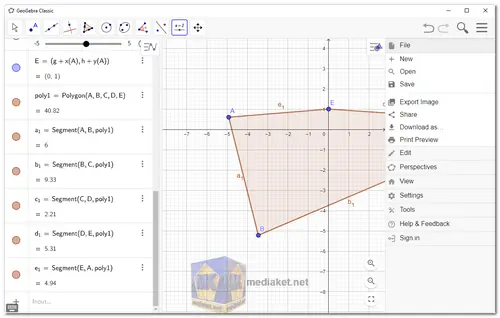GeoGebra is a free dynamic mathematics software that combines geometry, algebra, calculus, and other mathematical disciplines into an integrated and interactive learning environment. It provides a platform for students, teachers, and mathematicians to explore and visualize mathematical concepts, conduct experiments, and solve problems using digital tools...
GeoGebra is a free and open-source mathematical software application used in education for geometry, algebra, calculus, statistics, and more.
Here are some of the features of GeoGebra:
Interactive Geometry:
GeoGebra allows users to create and manipulate geometric objects such as points, lines, circles, and polygons, fostering a deeper understanding of geometric principles.
Algebraic Manipulation:
Users can perform algebraic calculations, equations solving, and symbolic computations, helping them explore algebraic relationships and concepts.
Calculus Tools:
The software includes tools for differentiation, integration, and visualization of functions and curves, making it valuable for calculus exploration.
Spreadsheet:
GeoGebra features a spreadsheet interface that allows users to create tables of data, perform statistical analysis, and generate visual representations.
3D Graphics:
Users can work in a three-dimensional environment, creating 3D objects and exploring spatial relationships.
Dynamic Linking:
GeoGebra allows dynamic connections between geometric, algebraic, and numeric representations, fostering a holistic understanding of mathematical concepts.
Scripting and Coding:
Advanced users can use scripting to create custom tools, animations, and simulations, enhancing the software's capabilities.
Interactive Learning Materials:
GeoGebra supports the creation of interactive learning materials, enabling educators to design engaging lessons and tutorials.
Visualization capabilities:
GeoGebra has powerful visualization capabilities, which can be used to create stunning mathematical visualizations. These visualizations can be used to help students understand mathematical concepts and to communicate mathematical ideas to others.
Collaboration capabilities:
GeoGebra supports collaboration, which means that multiple users can work on the same mathematical document at the same time. This makes it a great tool for distance learning and group projects.
GeoGebra free allows users to create interactive mathematical objects, such as points, lines, circles, graphs, and functions. GeoGebra can be used to explore mathematical concepts, solve problems, and create presentations.
Here are some of the pros of GeoGebra:
Free and Open Source:
GeoGebra is available for free, making it accessible to students and educators worldwide.
Versatile Learning Tool:
It caters to various mathematical domains, from geometry and algebra to calculus and beyond, promoting comprehensive mathematical exploration.
Visual and Interactive:
GeoGebra's interactive nature enhances visualization and concept understanding, making it particularly useful for learners who benefit from visual aids.
Teacher and Student-Friendly:
It's designed for both educators and students, facilitating personalized learning experiences and classroom teaching.
Cross-Platform:
GeoGebra is available as desktop and online versions, supporting various operating systems and devices.
Community and Resources:
A supportive community and extensive resources, including pre-built materials, lesson plans, and tutorials, enhance the learning and teaching experience.
Real-world Application:
GeoGebra's tools and simulations can model real-world scenarios, making it relevant beyond the classroom.
Constant Development:
The GeoGebra project is actively developed, ensuring ongoing improvements, new features, and bug fixes.
GeoGebra is a powerful and versatile mathematical software application that is a great option for both personal and professional use. It is free, easy to use, and supports a wide variety of mathematical concepts.
GeoGebra - Changelog:
Beta distribution added to probability calculator. Also corresponding commands BetaDist() and InverseBeta().
CAS fix for eg Sum(SequenceElement(Hcode, 1,jj)<>Element(HamCode, 1,jj*1,jj,1,n)) wrong.
LaTeX: fix spacing for accented letters eg í.
New parameter data-param-detachedKeyboardParent.
Data Table: import .CSV option added.
Install version:
Size: 111.64 MB - Download
Portable version:
Size: 111.71 MB - Download
How to use GeoGebra
Here's a guide to get you started with GeoGebra:
1. Access GeoGebra:
There are two ways to use GeoGebra:
- Online: GeoGebra offers a free web-based app. Just head to their website.
- Download: You can also download the software for your computer or mobile device. This might be useful if you prefer working offline.
2. Getting Familiar with the Interface:
GeoGebra has two main working areas:
- Graphics Window: This is the larger area where you will visually construct your geometric shapes, graphs, or 3D objects.
- Algebra Window (Input Bar): This is a panel on the left side (or on the bottom on mobile devices) where you can input algebraic expressions, equations, coordinates, or commands.
3. Basic Interactions:
- Points: Click anywhere in the graphics window to create a point. You can rename it later by double-clicking it and typing a new name in the input bar.
- Lines & Shapes: Select the desired tool from the toolbar (left side on desktop) and click/drag to create the object. GeoGebra offers various tools for lines, segments, rays, circles, polygons, etc.
- Moving & Selecting: Click and drag objects to move them around. Hold Ctrl (or Cmd on Mac) to select multiple objects.
4. Adding Equations & Functions:
- In the input bar, type your equation like "y = 2x + 1" or a function definition like "f(x) = sin(x)".
- Press Enter. GeoGebra will interpret the expression and create a corresponding graph or object in the graphics window.
5. Experimenting with Properties:
- Right-click on any object to access its properties. You can change its color, size, line style, and more from this menu.
- Play around with these properties to customize your constructions.
Learning More:
- GeoGebra offers a vast collection of tutorials and resources to help you explore its functionalities in more depth. Check out their website's tutorials section for video guides and written instructions on various topics.
- There are also beginner-friendly exercises available online to practice your GeoGebra skills.
This should give you a good starting point for using GeoGebra. As you explore further, you'll discover its advanced features for calculations, 3D geometry, probability, and more!

